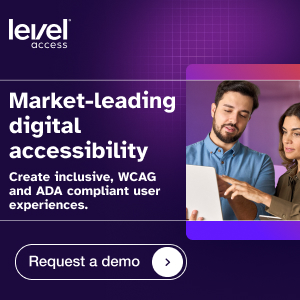Imagine you’re purchasing a used car. Before you sign the papers, you’ll probably want confirmation that it’s been inspected by a mechanic, so you know all systems work properly and the vehicle is safe to drive.
In the world of software procurement, a completed VPAT® (Voluntary Product Accessibility Template) offers buyers similar peace of mind. This document verifies that a digital product has been evaluated for accessibility, detailing the extent to which a product meets the needs of all users, including those with disabilities.
What is a VPAT?
A VPAT is a template used to document how effectively a digital product meets accessibility standards.
Developed by the Information Technology Industry Council (ITI), the VPAT serves as a comprehensive accessibility checklist for information and communication technology (ICT).
A completed VPAT, also known as a VPAT report or accessibility conformance report (ACR), provides procurement teams with in-depth insight on a product’s accessibility status. This documentation is now a standard requirement in the request for proposal (RFP) process.
The four editions of VPAT 2.4
The VPAT can be used to address different U.S. and international accessibility standards. The most recent version, VPAT 2.4, is available in four distinct formats, each tailored to specific compliance requirements.
- The Section 508 edition is specifically tailored to demonstrate conformance with the ICT accessibility requirements set forth by the U.S. federal government. It is commonly used by vendors developing software for government agencies, as it aligns with federal accessibility standards.
- The EU edition caters to the European market, incorporating the accessibility guidelines outlined in EN 301 549. To ensure adherence to local accessibility standards, this edition is highly recommended for products intended for use in European markets.
- The WCAG edition is designed to address the Web Content Accessibility Guidelines (WCAG), the compliance standard for many U.S. and international laws. This edition is widely used by vendors selling to private businesses in the U.S. and other markets where WCAG is the compliance benchmark.
- The international edition (INT) amalgamates multiple standards into one comprehensive document.
Consider it a complete template that encompasses global accessibility requirements, making it particularly useful for businesses selling products to public- and private-sector organizations across international markets.
Unpacking different standards
If you’re unsure which VPAT edition to use, consider the differences between the standards incorporated by each.
WCAG 2.1 or 2.2
WCAG addresses web content accessibility through four key principles:
- Perceivable information and user interface
- Operable user interface and navigation
- Understandable information and operation
- Robust content and reliable interpretation
Section 508
This standard incorporates WCAG 2.1 and focuses on federal ICT requirements. It covers a range of ICT products, including:
- Software applications and operating systems
- Web-based intranet and internet information
- Telecommunications products
- Video and multimedia products
- Self-contained products
EN 301 549 (European standard)
This standard, adopted by European laws, incorporates WCAG 2.1 along with additional criteria addressing:
- Biometrics
- Closed functionality
- Two-way voice communication
- Education-specific requirements
Why VPAT matters: Beyond compliance
For software buyers, obtaining a VPAT from potential vendors enables procurement officers to make sound choices. By clearly outlining the accessibility features supported and addressing potential barriers, this document equips decision makers with the information needed to procure inclusive, compliant technology.
For vendors, a VPAT from a reputable expert can unlock valuable business opportunities, enabling companies to sell to organizations that must comply with digital accessibility laws and regulations.
Completing a VPAT: A methodical approach
The development of a VPAT report necessitates a comprehensive understanding of accessibility standards, and is best performed by an expert. The VPAT completion process includes the following steps:
- Conducting a thorough accessibility audit: Manually evaluate the product to identify any gaps in conformance with relevant accessibility standards. For accurate results, this evaluation should include testing by native users of assistive technologies (AT).
- Documenting the product’s level of conformance: Based on the evaluation, detail whether the product meets each criterion in the VPAT. A VPAT utilizes specific terminology to denote conformance: Supports, Partially Supports, Does Not Support, and Not Applicable. Each assertion must be substantiated with concrete evidence from testing results.
- Explaining any limitations in accessibility: Provide detailed explanations for any identified accessibility limitations or areas of partial support. If certain features are not fully accessible, describe any available alternatives and provide instructions for users to work around these limitations effectively.
Updating your VPAT
Many vendors make the mistake of approaching VPAT reporting as a one-time project.
As products undergo advancements and modifications, conformance documentation must stay in alignment. Organizations should evaluate products on an ongoing basis and aim to update a product’s VPAT annually. VPAT reports that are more than two years old are generally regarded as outdated and unreliable by buyers.
VPAT conformance levels: A deeper dive
Understanding the different conformance levels in VPAT documentation is crucial for accurate reporting. Let’s explore each level and what it means.
Supports (S)
When your product fully meets an accessibility criterion without known defects, you can use the “Supports” designation. For example, if your web application provides proper keyboard navigation throughout all features, you would mark keyboard accessibility criteria as “Supports.” This means users can access every function using only a keyboard, with no exceptions or limitations.
Partially Supports (PS)
Some features might be accessible to certain users, but have limitations. A “Partially Supports” designation acknowledges this nuance. When using “Partially Supports,” it’s important to detail exactly which aspects meet the criterion and which need improvement.
Does Not Support (DNS)
When a feature doesn’t meet accessibility requirements, honesty is crucial. “Does Not Support” doesn’t mean failure—it means you’re transparent about a product’s current limitations. For instance, if your application’s color scheme doesn’t meet minimum contrast requirements, you would mark contrast-related criteria as “Does Not Support.”
Not Applicable (NA)
Some criteria might not apply to your product. A text-only document repository, for example, wouldn’t need to report on video caption criteria. Use “Not Applicable” carefully and always explain why the criterion doesn’t apply to your specific product.
Not Evaluated (NE)
In some cases, certain features or aspects haven’t been assessed for accessibility compliance. While it’s better to evaluate everything, sometimes time or resource constraints necessitate partial evaluation. Be clear about what hasn’t been evaluated and why.
Best practices for documenting conformance levels
When documenting accessibility conformance in a VPAT, adhere to these best practices:
- Provide detailed explanations: Provide specific examples of how a product supports, does not support, or partially supports a criterion (e.g., “Feature X Supports keyboard navigation through all menu items using standard Tab and Arrow keys.”).
- Include testing information: Describe testing methodologies and results (e.g., “Contrast ratios were tested using WebAIM’s contrast checker across all interface elements.”)
- Outline remediation plans: For “Partially Supports” or “Does Not Support” items, outline future improvements (e.g., “Planning to implement a high-contrast scheme in Q3 2025 to address contrast ratio requirements.”).
- Offer context: Add relevant context for “Not Applicable” designations (e.g., “Audio description criteria marked as NA as the platform contains no video content.”).
VPAT reports: A vital resource in product procurement
VPATs are increasingly required in business-to-business (B2B) and business-to-government (B2G) digital product procurement.
An accurate VPAT report from a reliable accessibility expert can equip your organization with a key competitive edge.
The value of a VPAT goes beyond sales opportunities: By obtaining a clear, honest assessment of your product’s accessibility features, you can gain the insight you need to address barriers and ultimately deliver a higher quality user experience for all.

